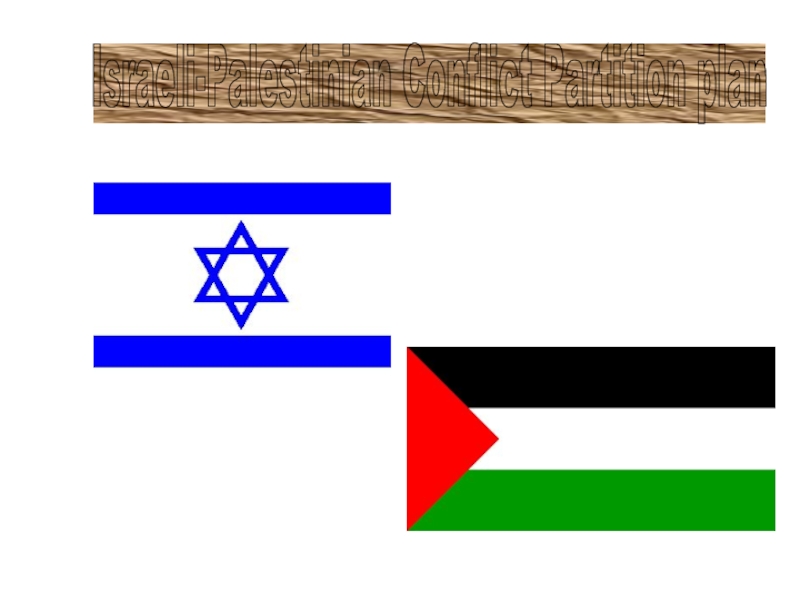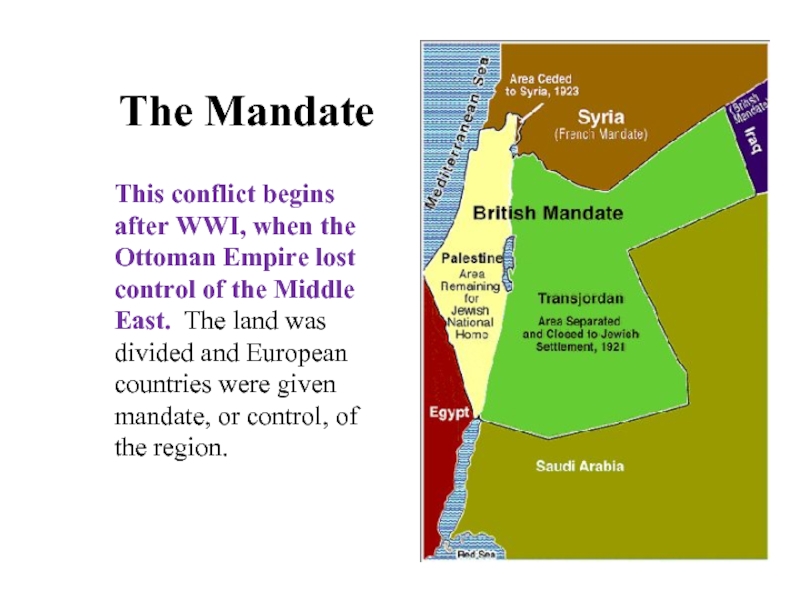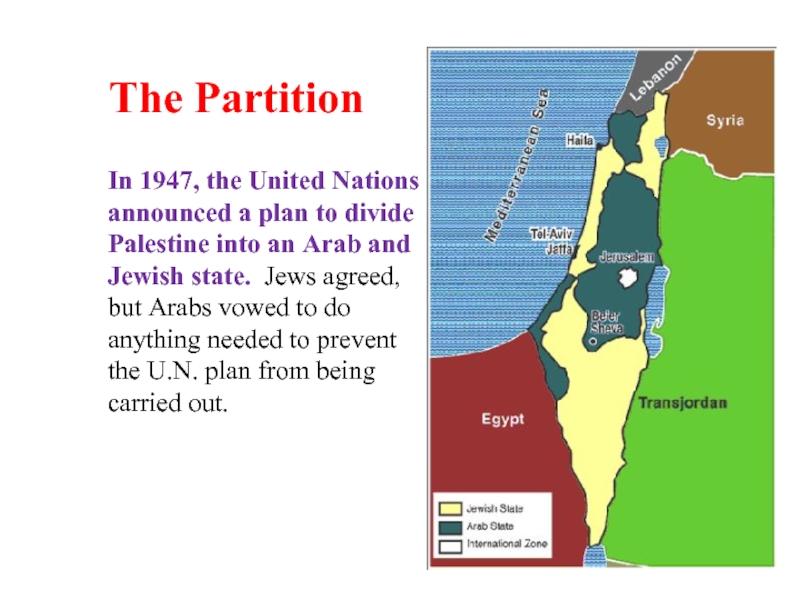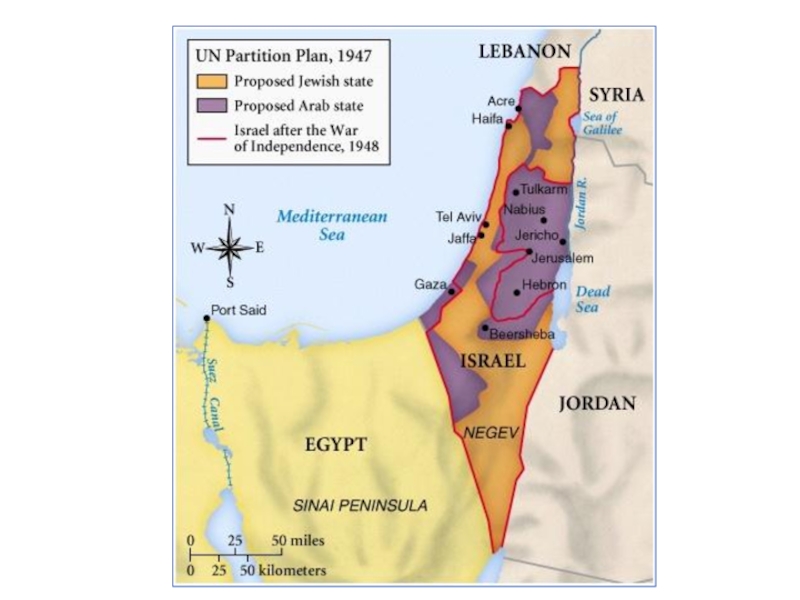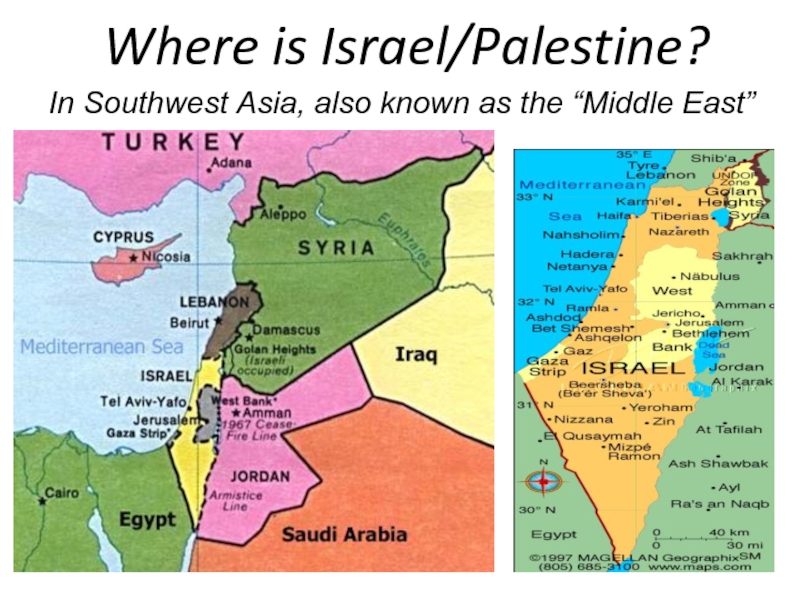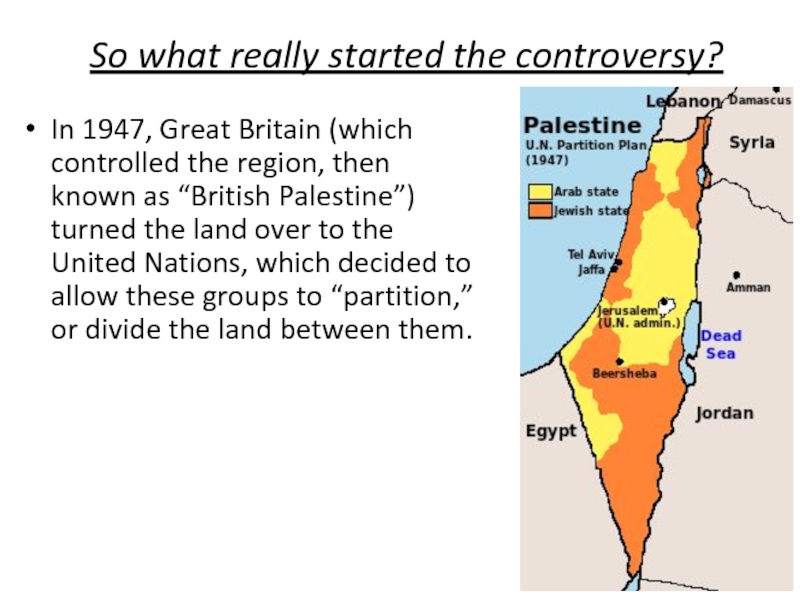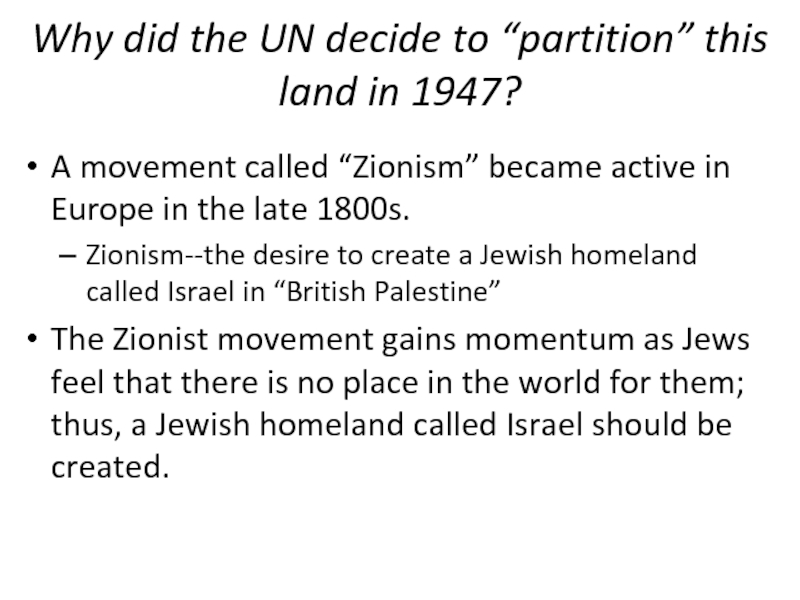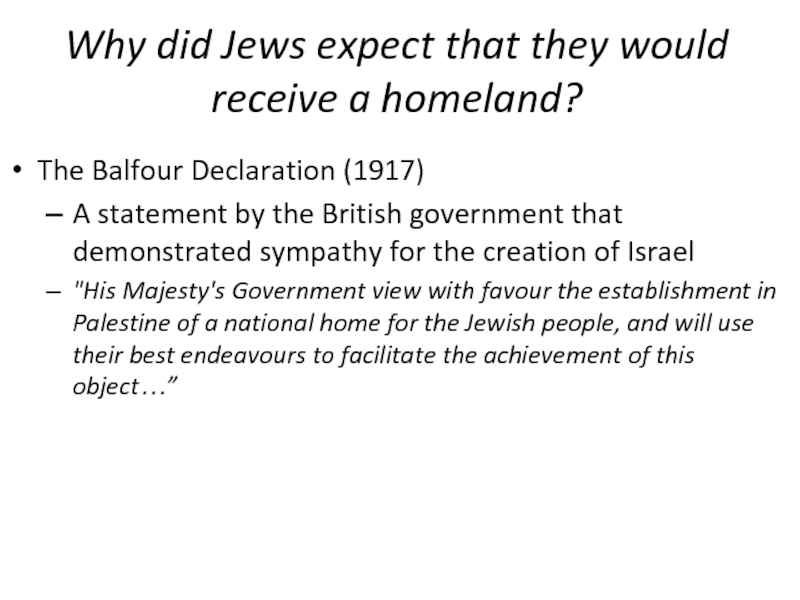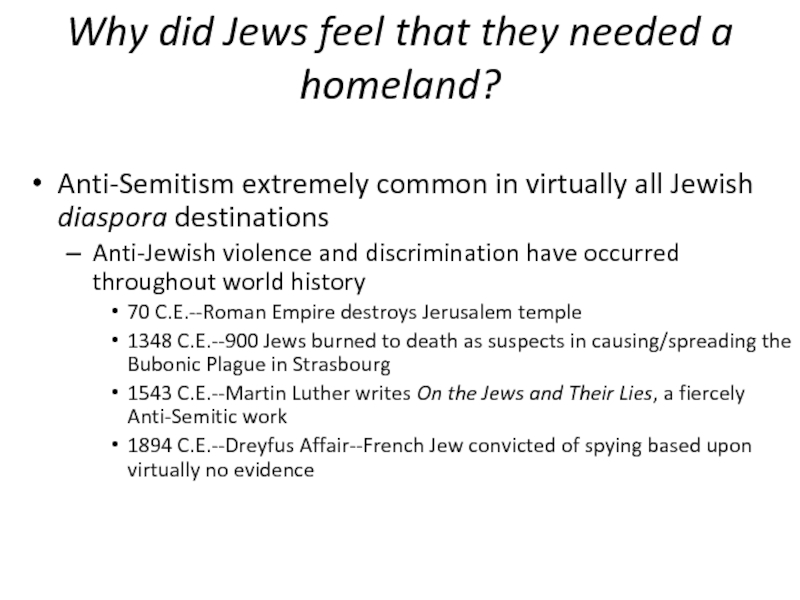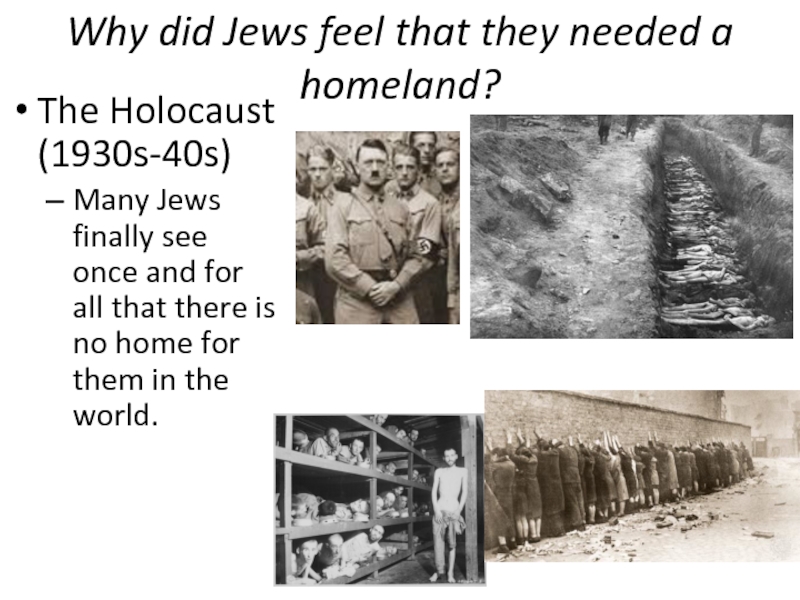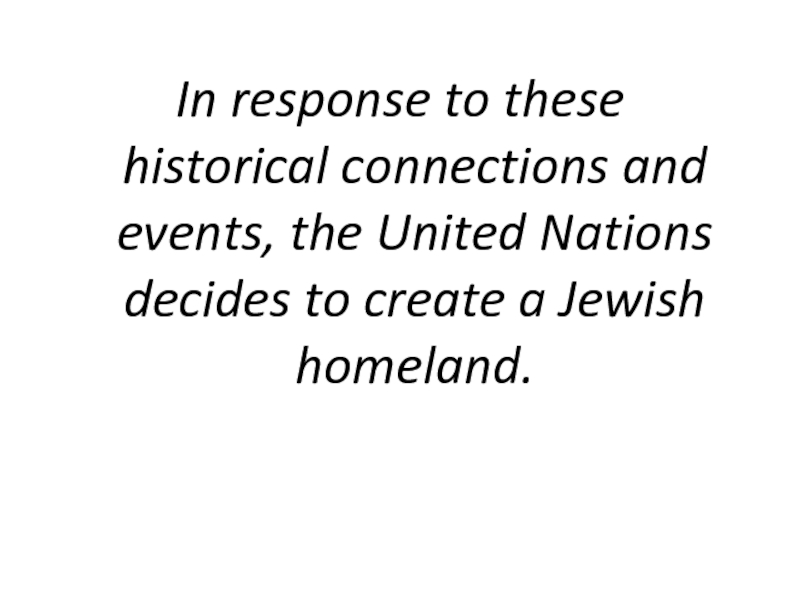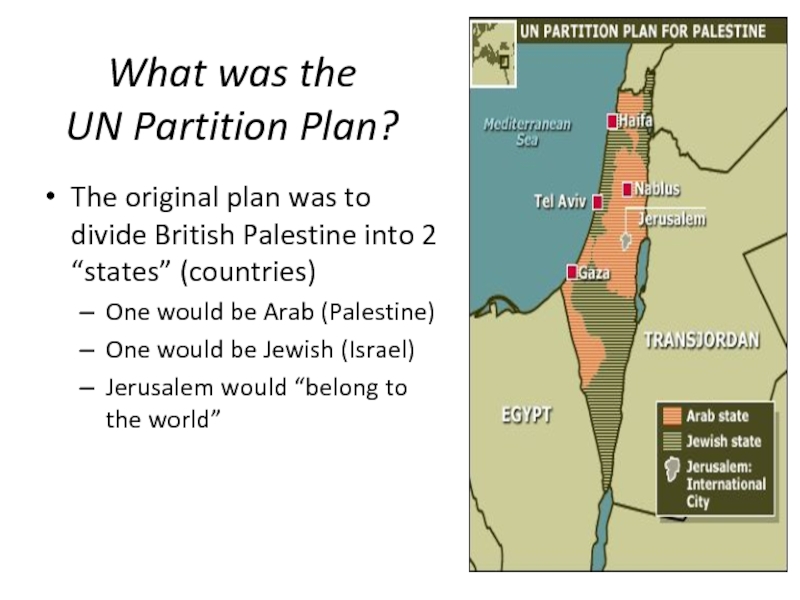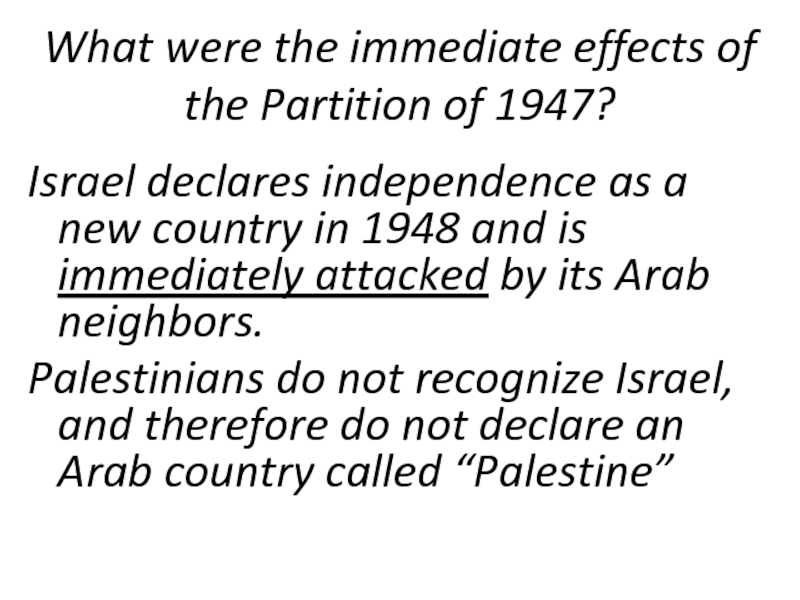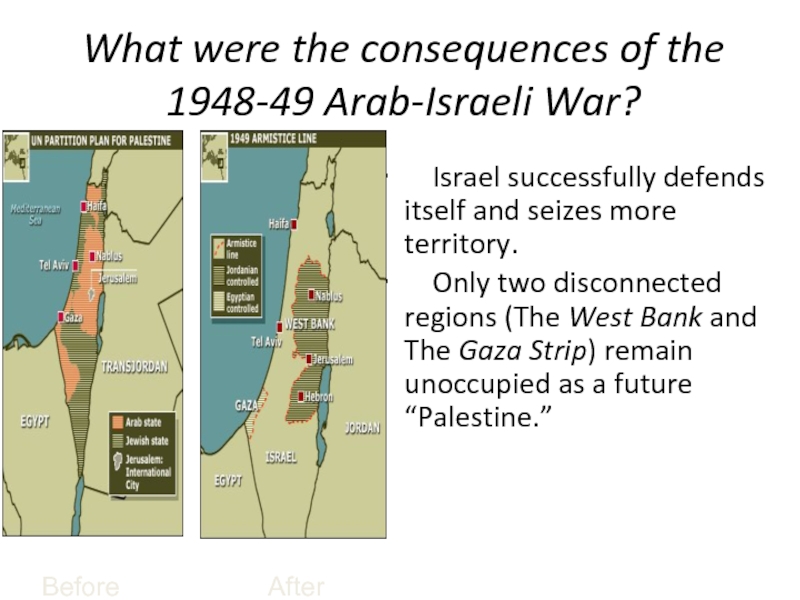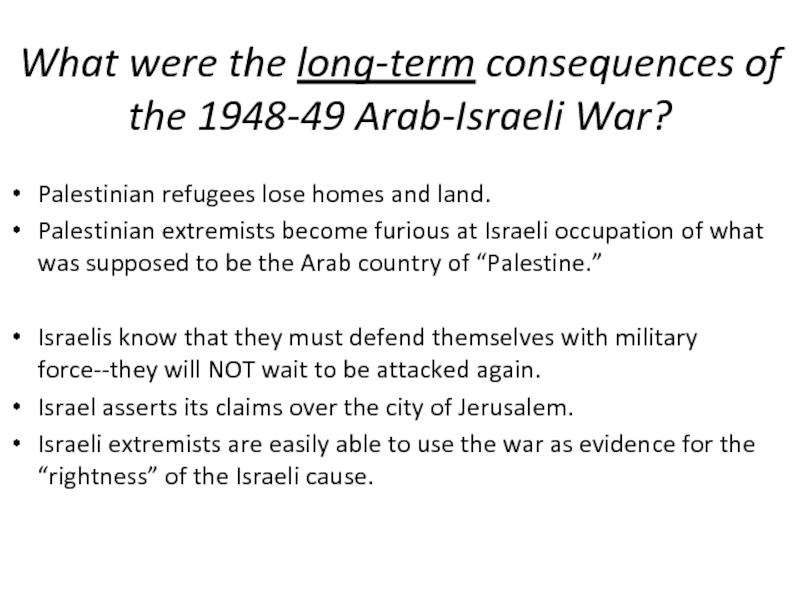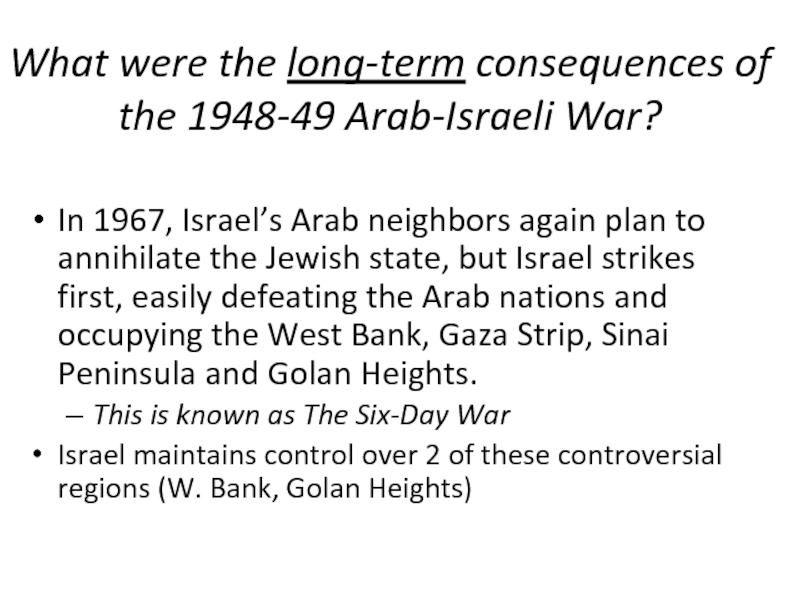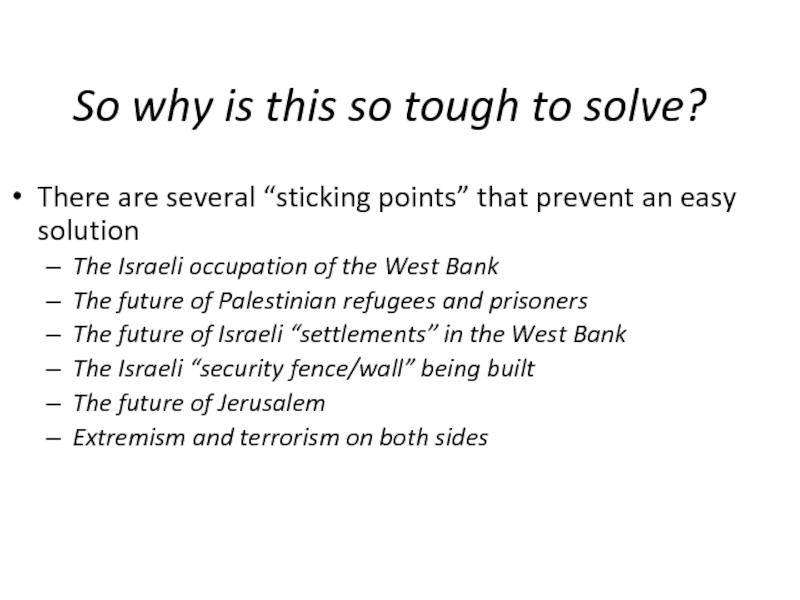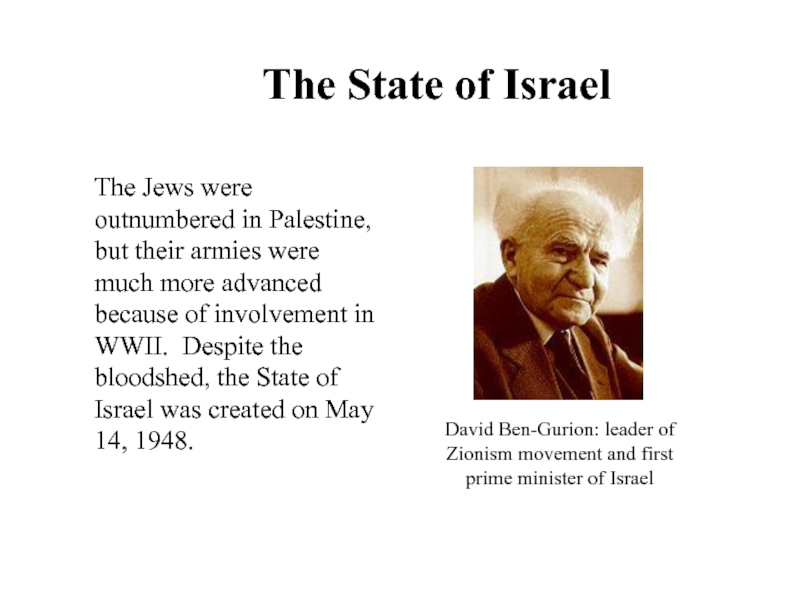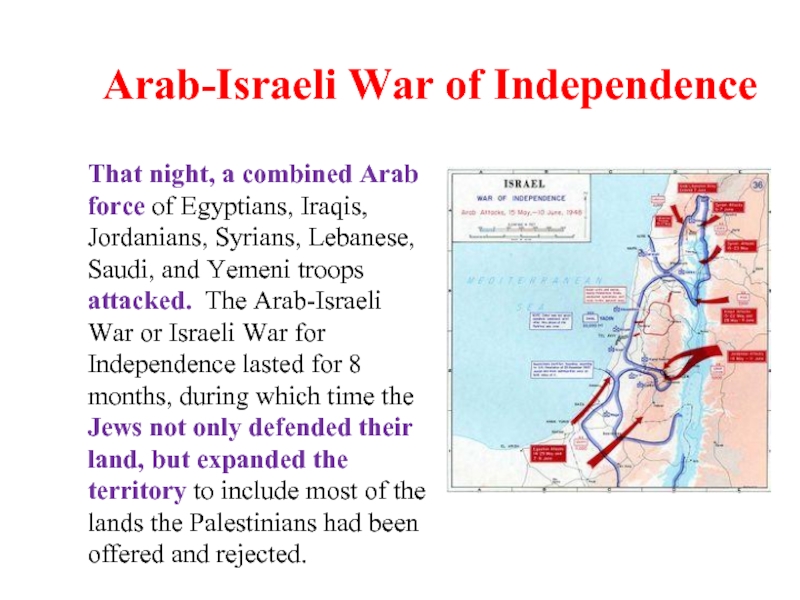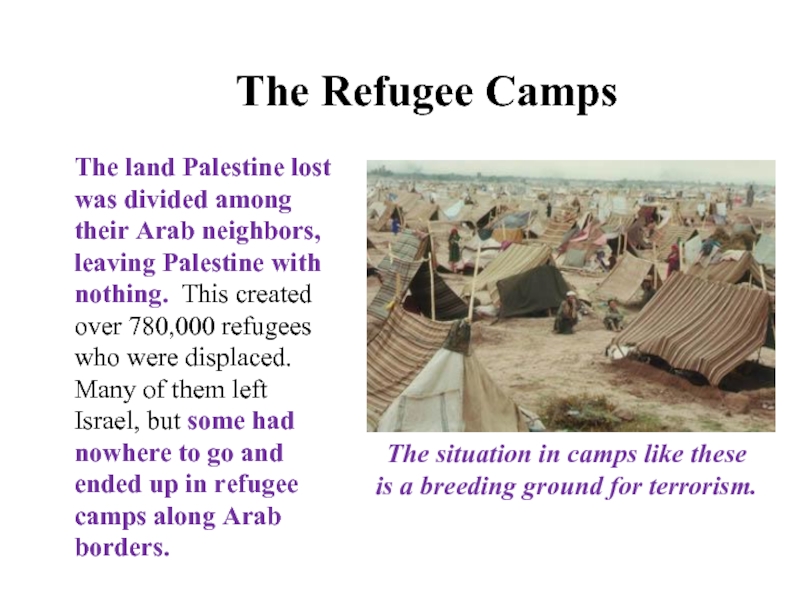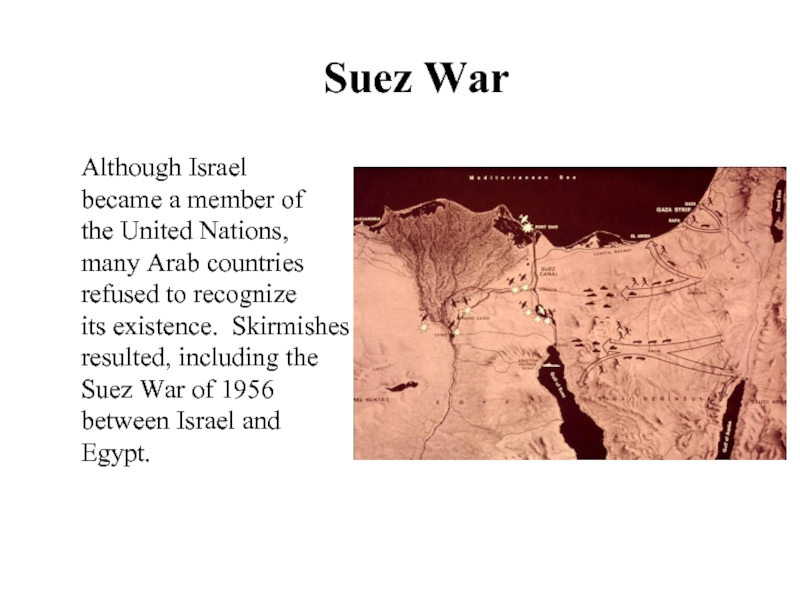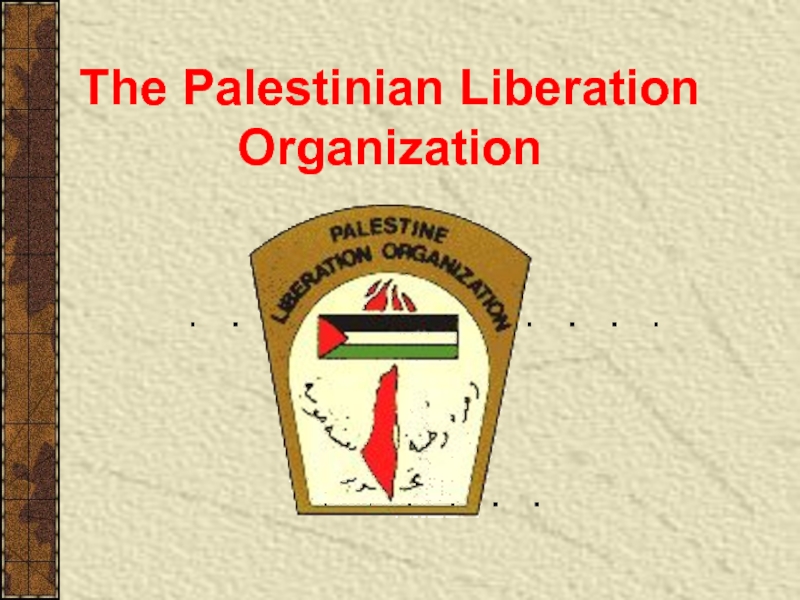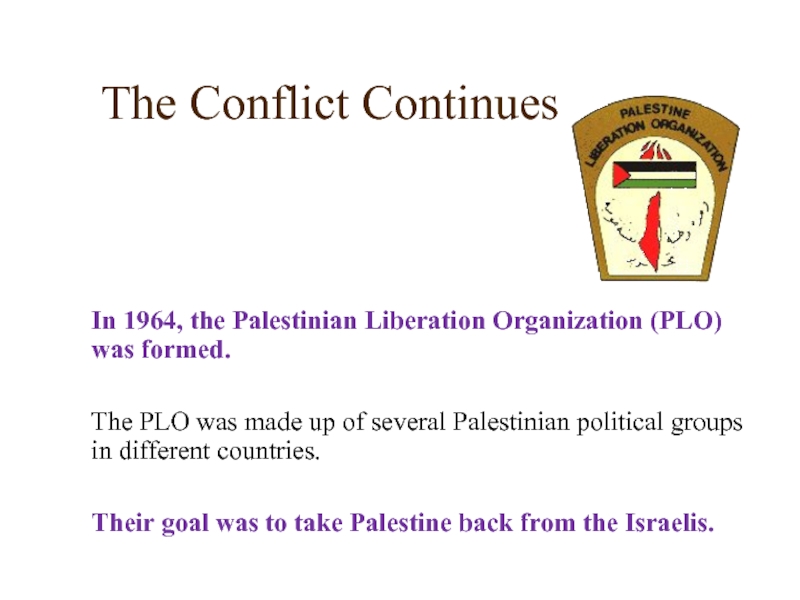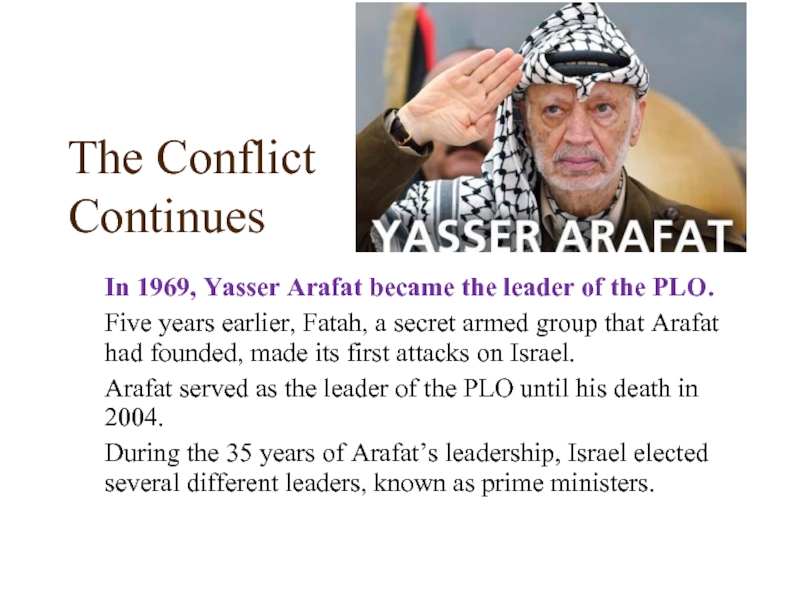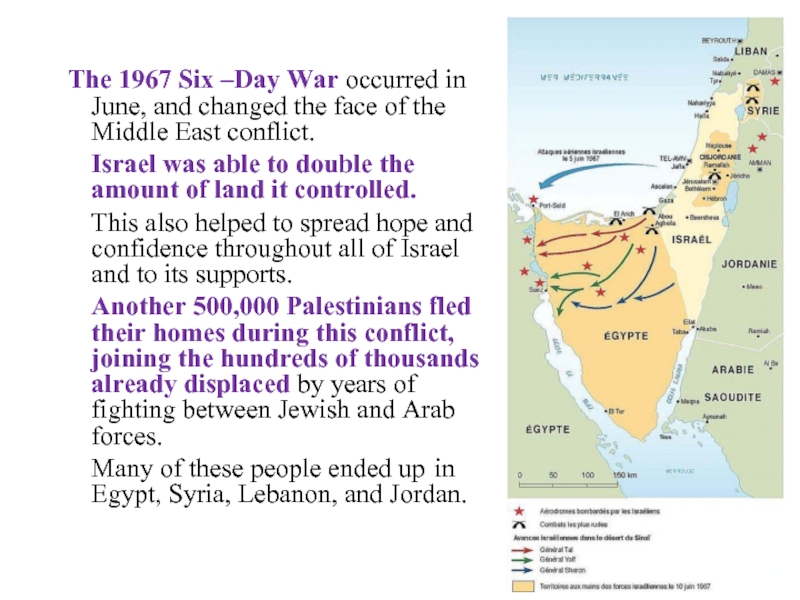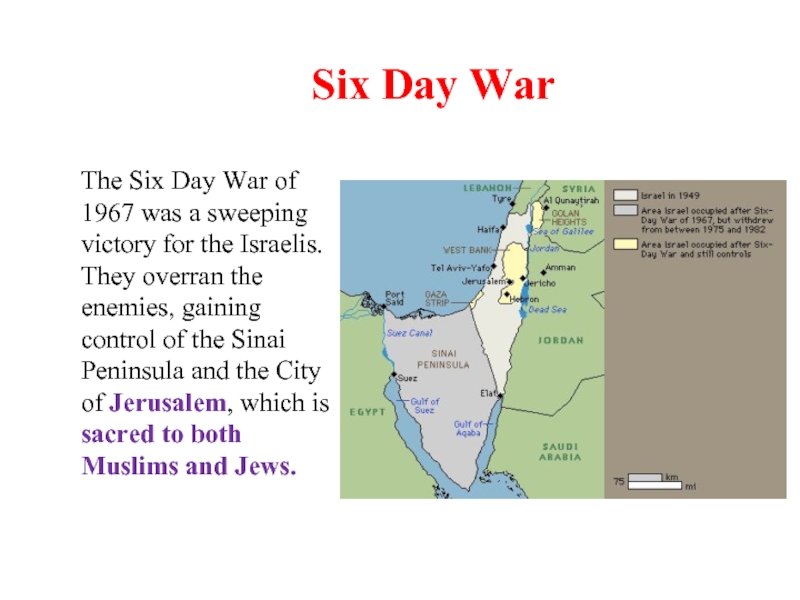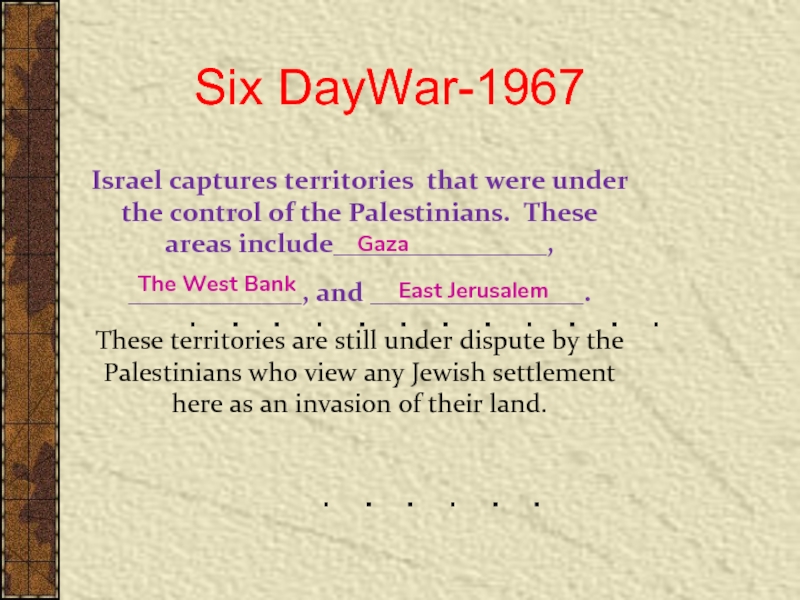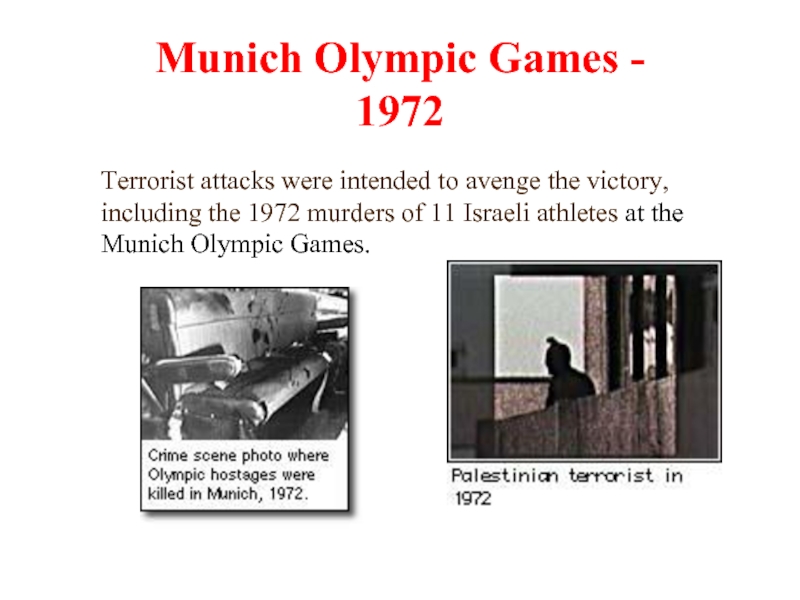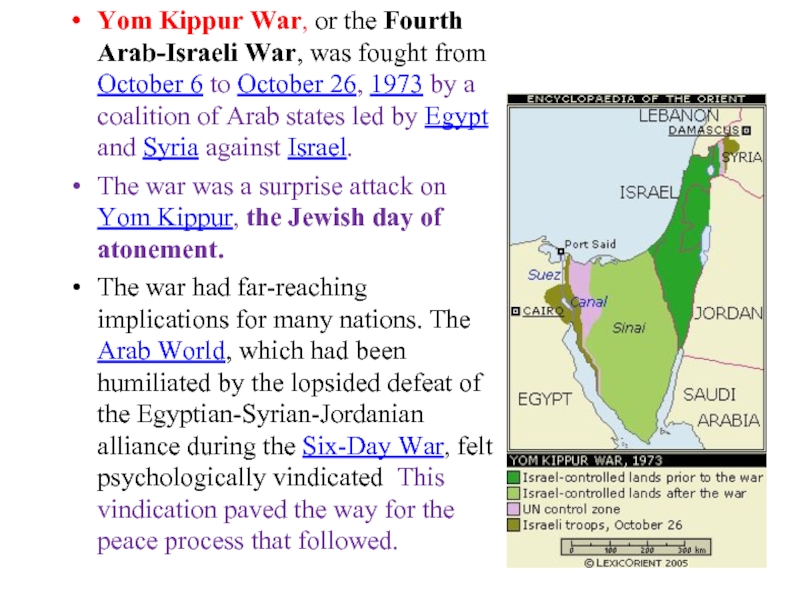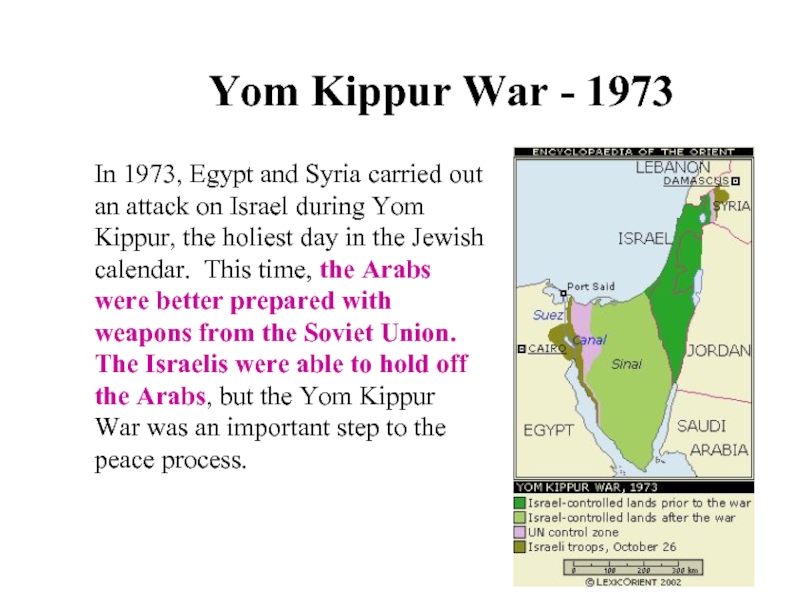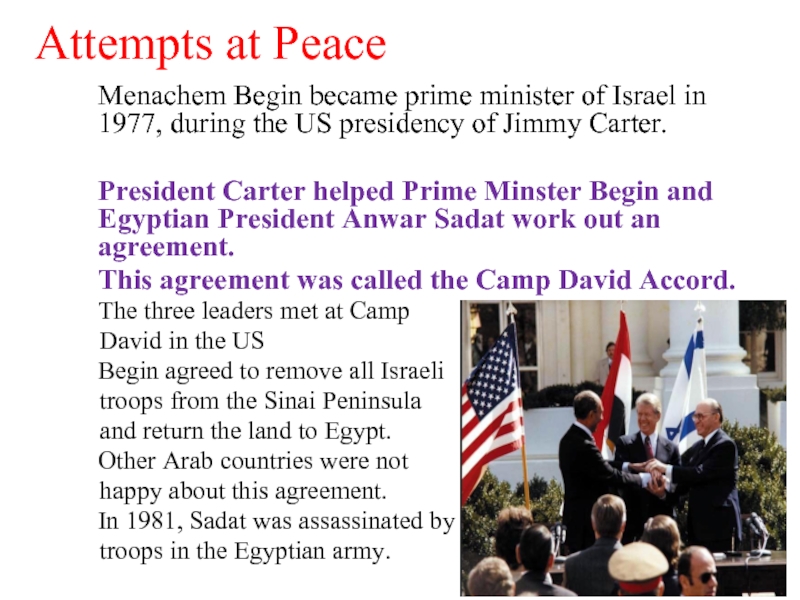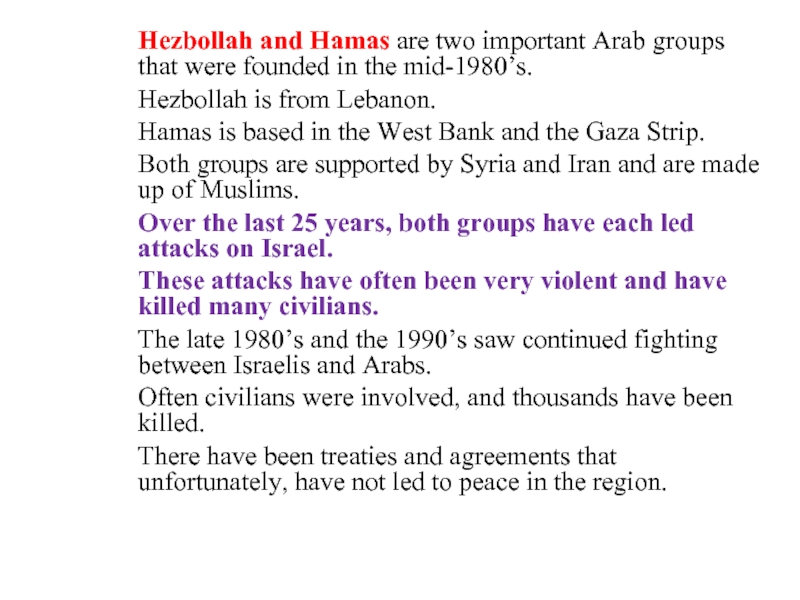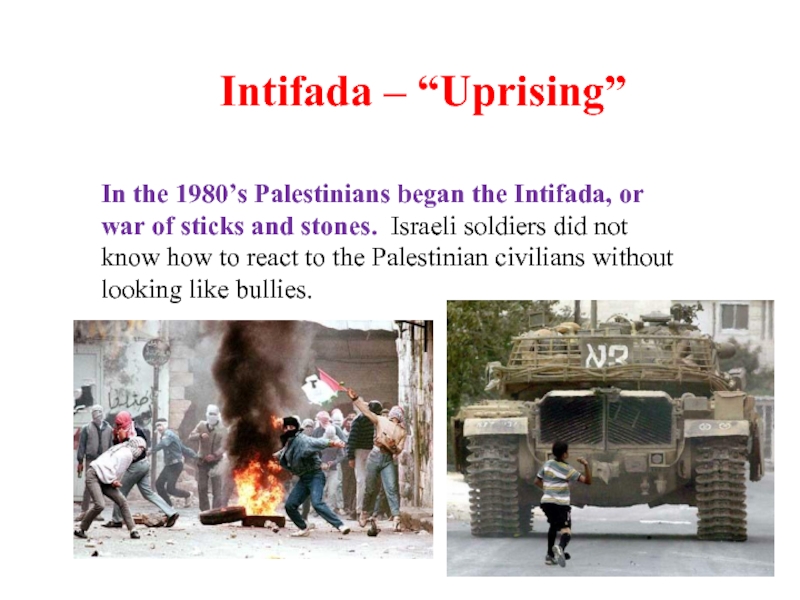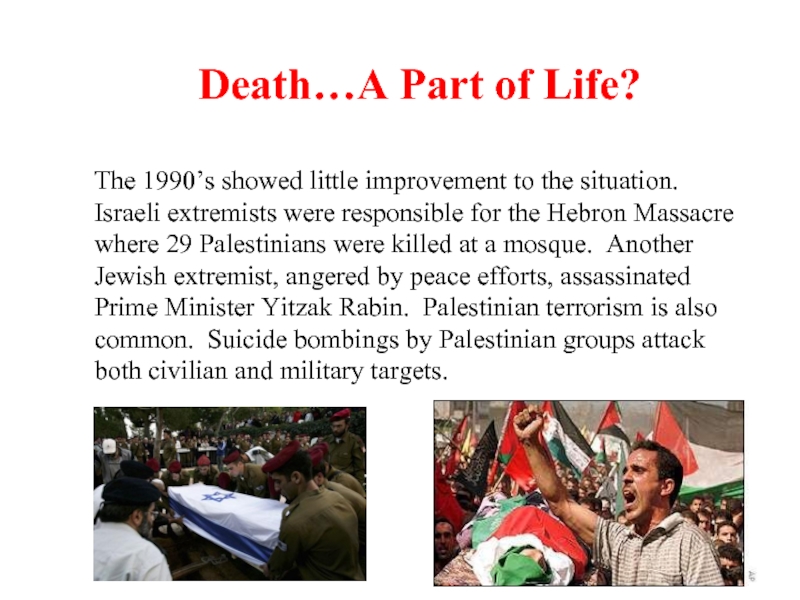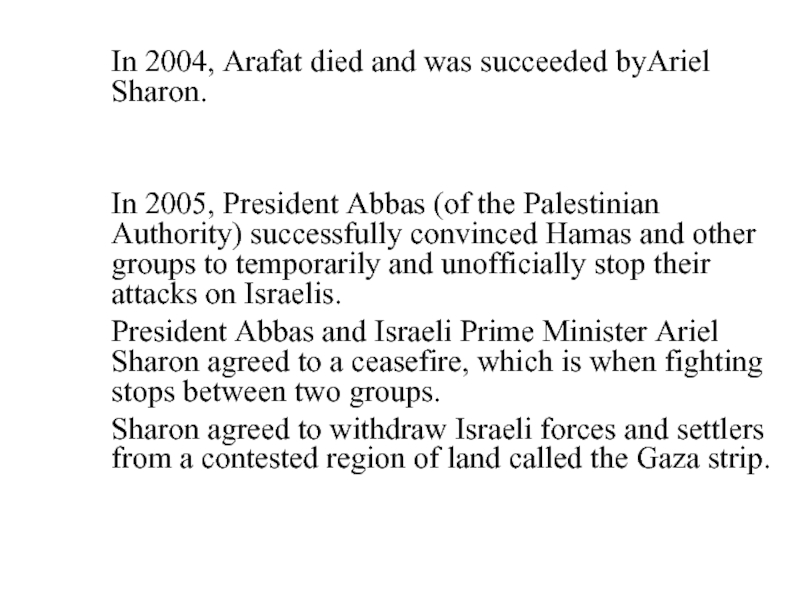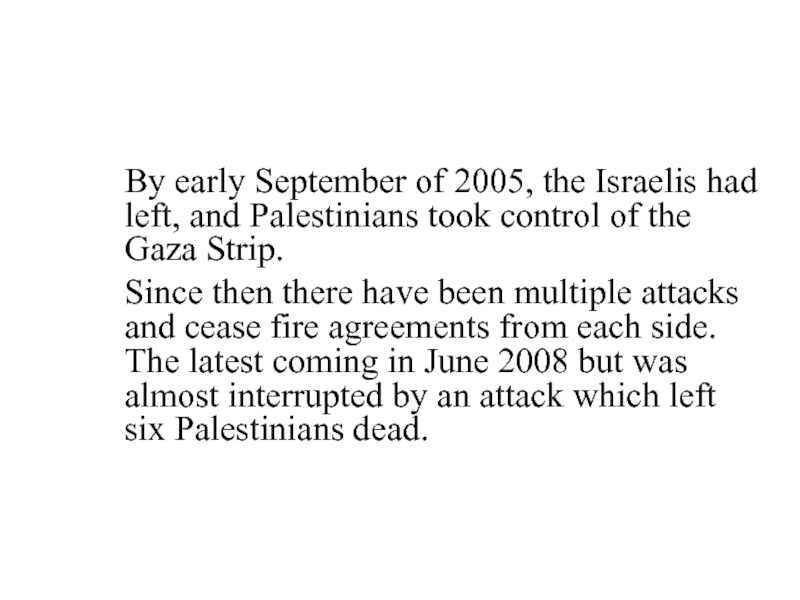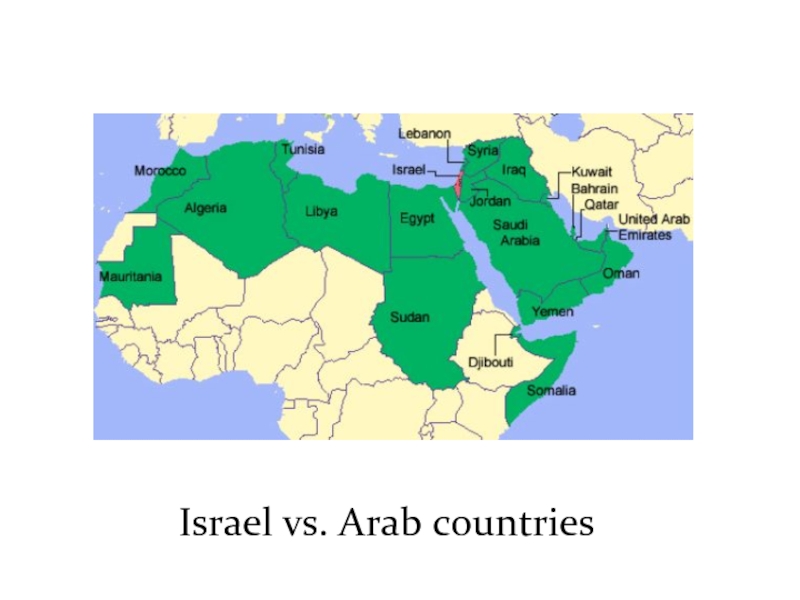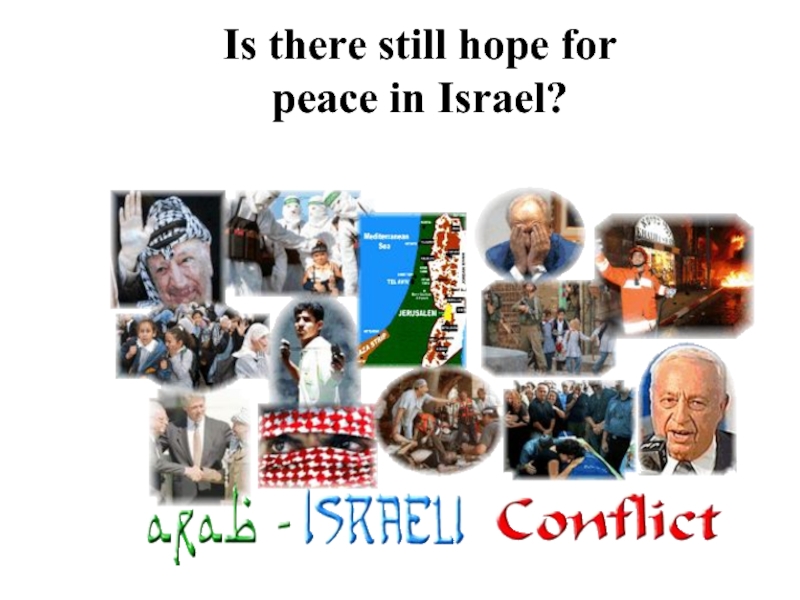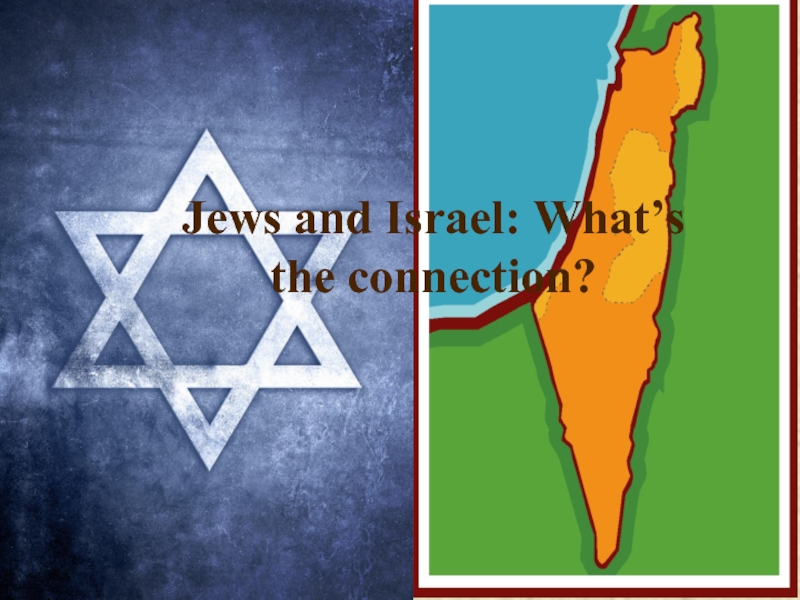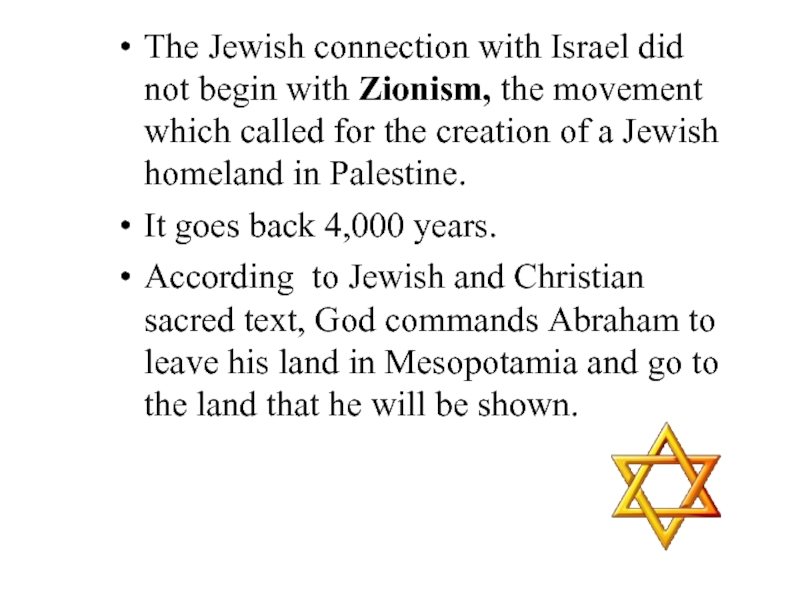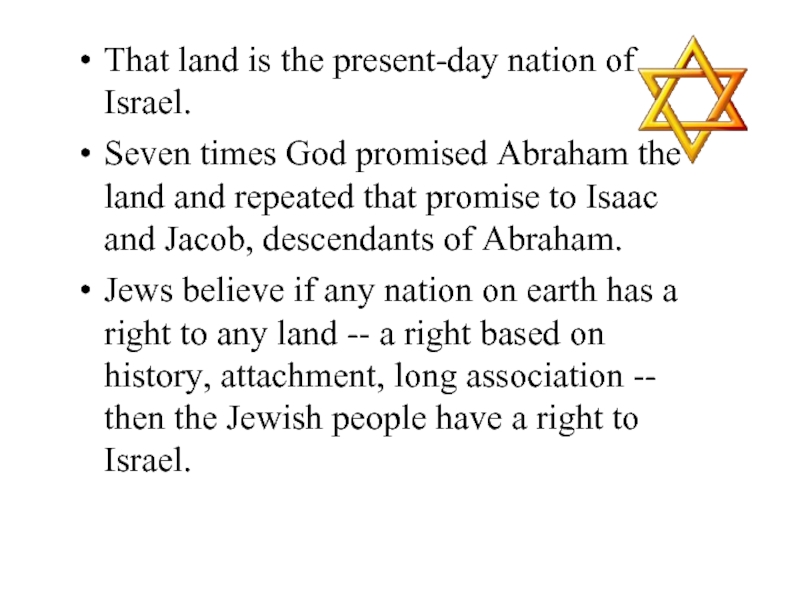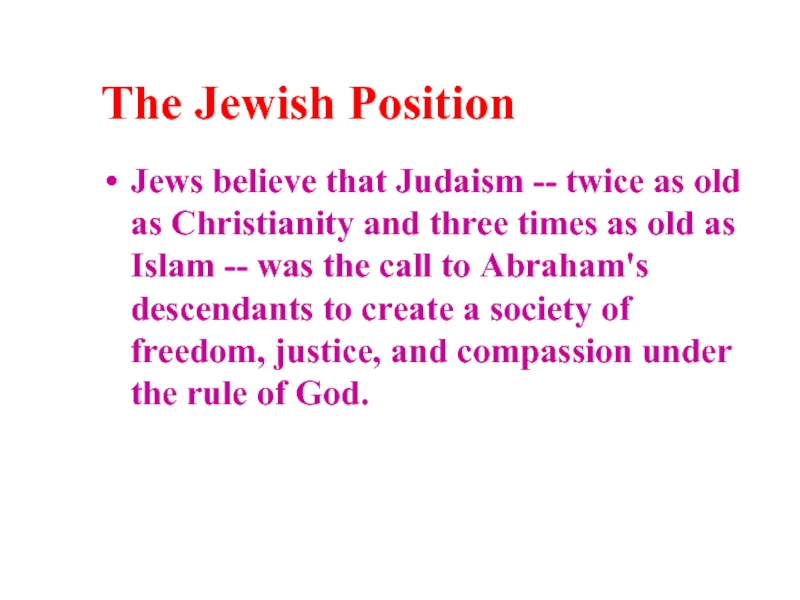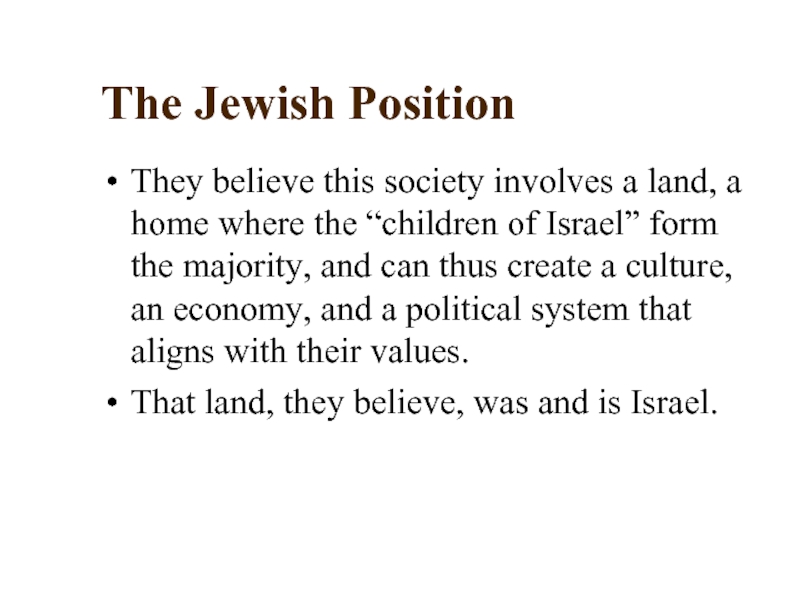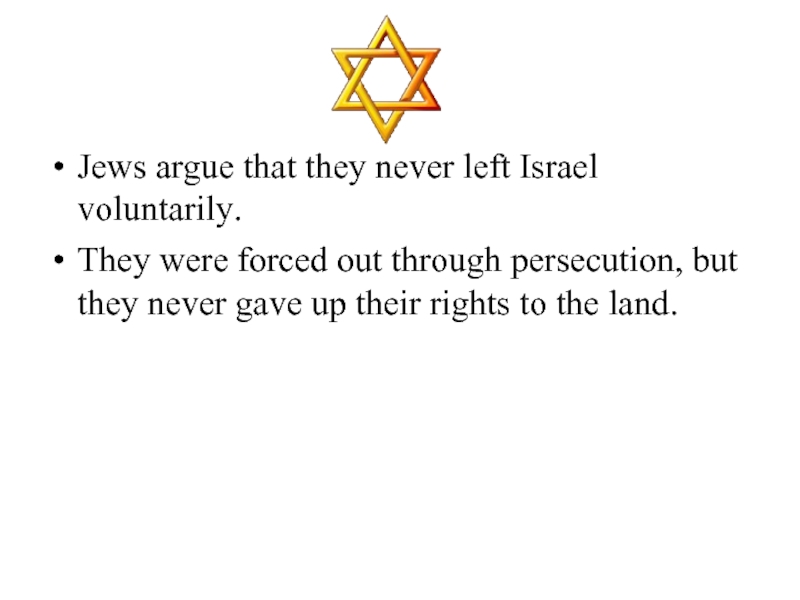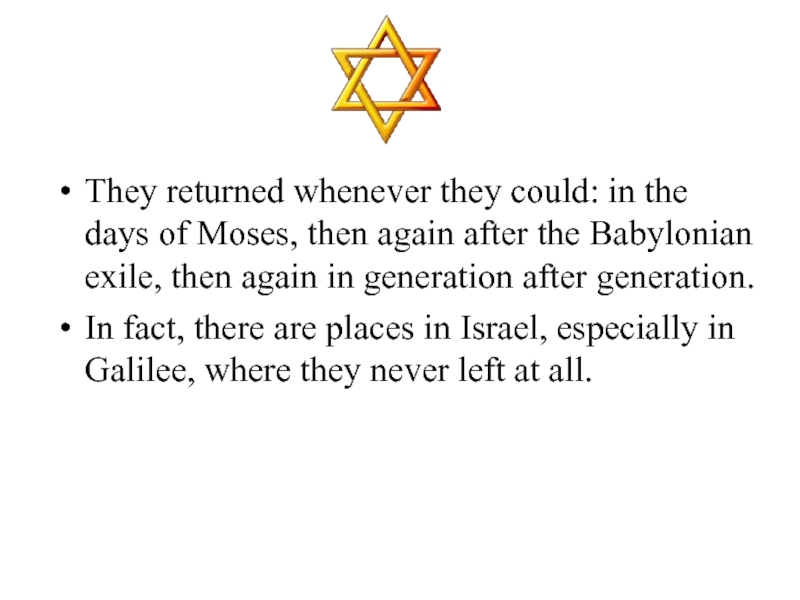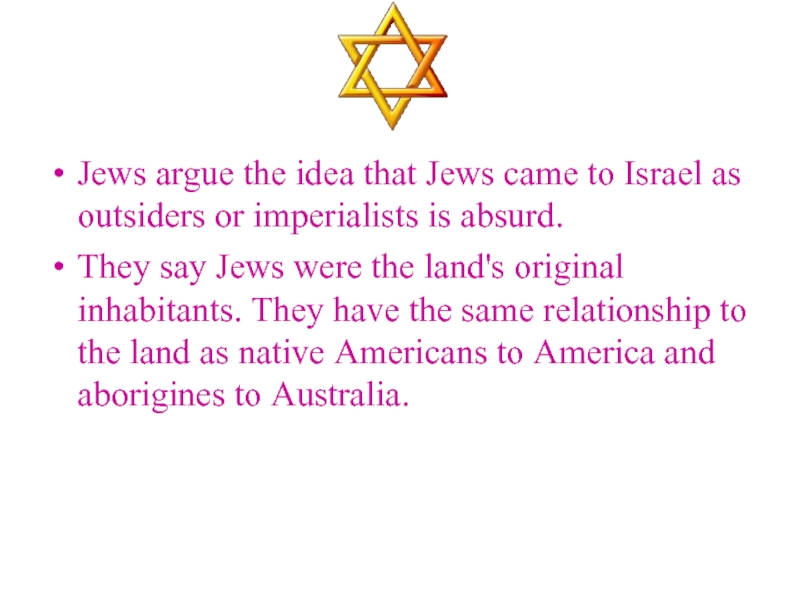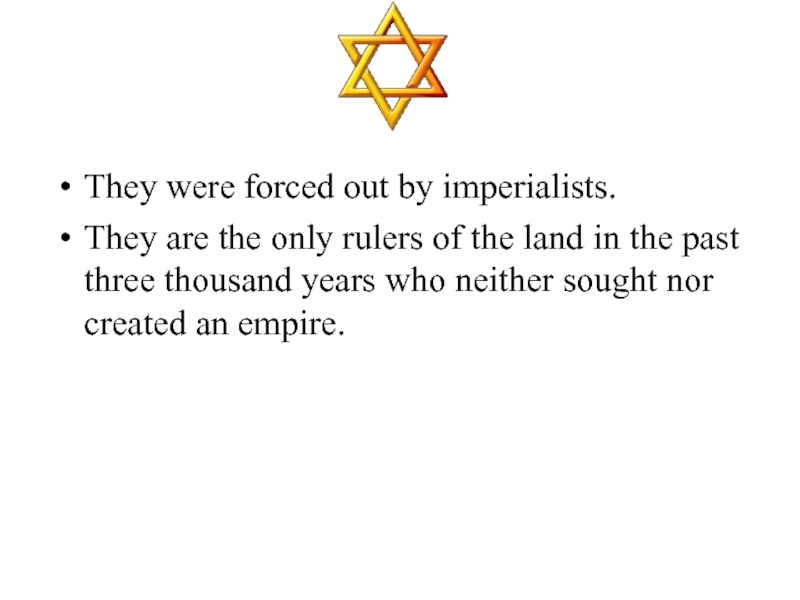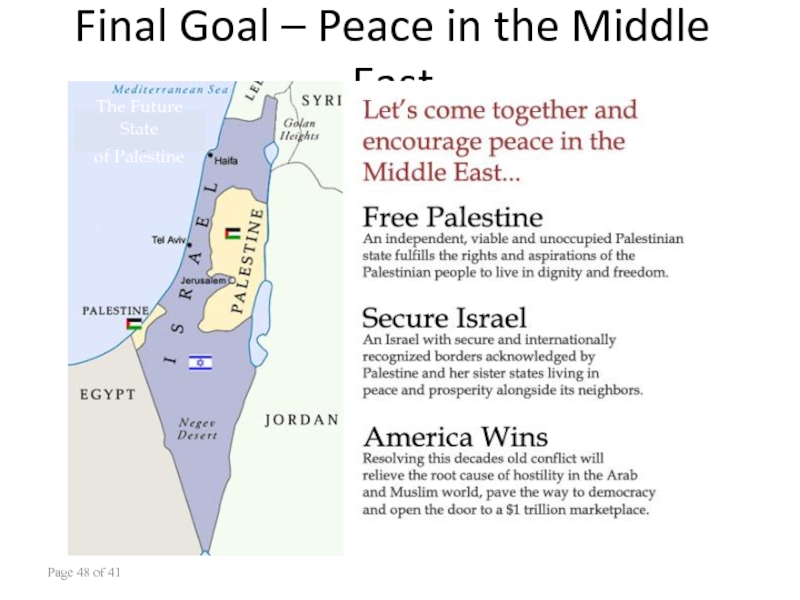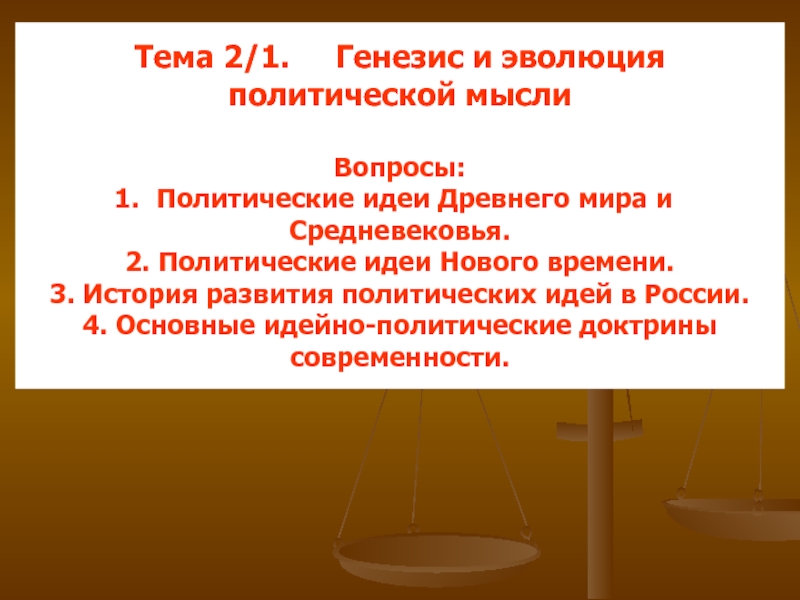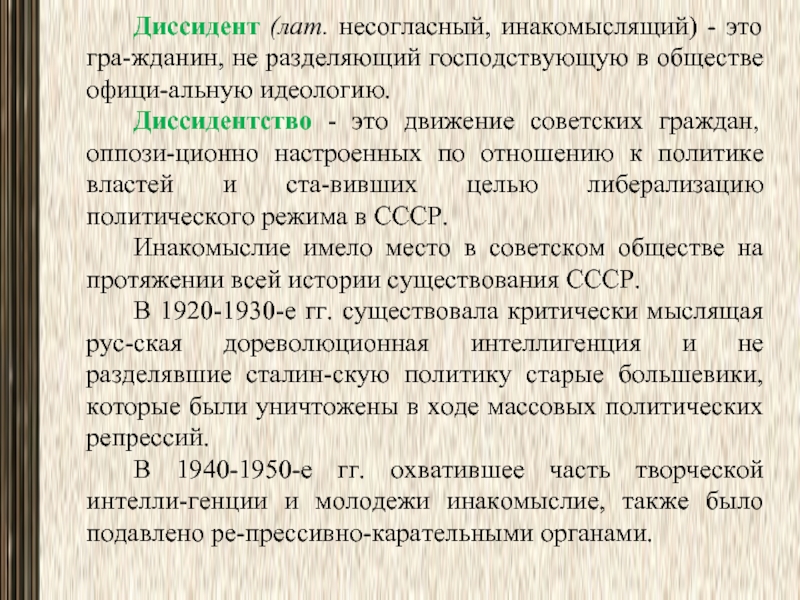- Главная
- Разное
- Дизайн
- Бизнес и предпринимательство
- Аналитика
- Образование
- Развлечения
- Красота и здоровье
- Финансы
- Государство
- Путешествия
- Спорт
- Недвижимость
- Армия
- Графика
- Культурология
- Еда и кулинария
- Лингвистика
- Английский язык
- Астрономия
- Алгебра
- Биология
- География
- Детские презентации
- Информатика
- История
- Литература
- Маркетинг
- Математика
- Медицина
- Менеджмент
- Музыка
- МХК
- Немецкий язык
- ОБЖ
- Обществознание
- Окружающий мир
- Педагогика
- Русский язык
- Технология
- Физика
- Философия
- Химия
- Шаблоны, картинки для презентаций
- Экология
- Экономика
- Юриспруденция
Israeli-Palestinian Conflict. Partition plan презентация
Содержание
- 1. Israeli-Palestinian Conflict. Partition plan
- 2. This conflict begins after WWI, when the
- 3. In 1947, the United Nations announced a
- 5. Where is Israel/Palestine? In Southwest Asia, also known as the “Middle East”
- 6. So what really started the controversy? In
- 7. Why did the UN decide to “partition”
- 8. Why did Jews expect that they would
- 9. Why did Jews feel that they needed
- 10. Why did Jews feel that they needed
- 11. In response to these historical connections and
- 12. What was the UN Partition Plan?
- 13. What were the immediate effects of the
- 14. What were the consequences of the 1948-49
- 15. What were the long-term consequences of the
- 16. What were the long-term consequences of the
- 17. So why is this so tough to
- 18. The Jews were outnumbered in Palestine, but
- 19. That night, a combined Arab force of
- 20. The land Palestine lost was divided
- 21. Although Israel became a member of
- 22. The Palestinian Liberation Organization
- 23. The Conflict Continues In 1964, the Palestinian
- 24. The Conflict Continues In 1969, Yasser
- 25. The 1967 Six –Day War occurred
- 26. The Six Day War of 1967 was
- 27. Six DayWar-1967 Israel captures territories that
- 28. Terrorist attacks were intended to avenge the
- 29. Yom Kippur War, or the Fourth Arab-Israeli
- 30. In 1973, Egypt and Syria carried out
- 31. Attempts at Peace Menachem Begin became prime
- 32. Hezbollah and Hamas are two important Arab
- 33. In the 1980’s Palestinians began the Intifada,
- 34. The 1990’s showed little improvement to the
- 35. In 2004, Arafat died and was
- 36. By early September of 2005, the
- 37. Israel vs. Arab countries
- 38. Is there still hope for peace in Israel?
- 39. Jews and Israel: What’s the connection?
- 40. The Jewish connection with Israel did not
- 41. That land is the present-day nation of
- 42. The Jewish Position Jews believe that Judaism
- 43. The Jewish Position They believe this society
- 44. Jews argue that they never left Israel
- 45. They returned whenever they could:
- 46. Jews argue the idea that Jews came
- 47. They were forced out by imperialists.
- 48. Page of 41 Final Goal – Peace
- 49. Thanks for your attention! Done by Serikkazieva Moldir
Слайд 2This conflict begins after WWI, when the Ottoman Empire lost control
The Mandate
Слайд 3In 1947, the United Nations announced a plan to divide Palestine
The Partition
Слайд 6So what really started the controversy?
In 1947, Great Britain (which controlled
Слайд 7Why did the UN decide to “partition” this land in 1947?
A
Zionism--the desire to create a Jewish homeland called Israel in “British Palestine”
The Zionist movement gains momentum as Jews feel that there is no place in the world for them; thus, a Jewish homeland called Israel should be created.
Слайд 8Why did Jews expect that they would receive a homeland?
The Balfour
A statement by the British government that demonstrated sympathy for the creation of Israel
"His Majesty's Government view with favour the establishment in Palestine of a national home for the Jewish people, and will use their best endeavours to facilitate the achievement of this object…”
Слайд 9Why did Jews feel that they needed a homeland?
Anti-Semitism extremely common
Anti-Jewish violence and discrimination have occurred throughout world history
70 C.E.--Roman Empire destroys Jerusalem temple
1348 C.E.--900 Jews burned to death as suspects in causing/spreading the Bubonic Plague in Strasbourg
1543 C.E.--Martin Luther writes On the Jews and Their Lies, a fiercely Anti-Semitic work
1894 C.E.--Dreyfus Affair--French Jew convicted of spying based upon virtually no evidence
Слайд 10Why did Jews feel that they needed a homeland?
The Holocaust (1930s-40s)
Many
Слайд 11In response to these historical connections and events, the United Nations
Слайд 12What was the
UN Partition Plan?
The original plan was to divide
One would be Arab (Palestine)
One would be Jewish (Israel)
Jerusalem would “belong to the world”
Слайд 13What were the immediate effects of the Partition of 1947?
Israel declares
Palestinians do not recognize Israel, and therefore do not declare an Arab country called “Palestine”
Слайд 14What were the consequences of the 1948-49 Arab-Israeli War?
Israel
Only two disconnected regions (The West Bank and The Gaza Strip) remain unoccupied as a future “Palestine.”
Before
After
Слайд 15What were the long-term consequences of the 1948-49 Arab-Israeli War?
Palestinian refugees
Palestinian extremists become furious at Israeli occupation of what was supposed to be the Arab country of “Palestine.”
Israelis know that they must defend themselves with military force--they will NOT wait to be attacked again.
Israel asserts its claims over the city of Jerusalem.
Israeli extremists are easily able to use the war as evidence for the “rightness” of the Israeli cause.
Слайд 16What were the long-term consequences of the 1948-49 Arab-Israeli War?
In 1967,
This is known as The Six-Day War
Israel maintains control over 2 of these controversial regions (W. Bank, Golan Heights)
Слайд 17So why is this so tough to solve?
There are several “sticking
The Israeli occupation of the West Bank
The future of Palestinian refugees and prisoners
The future of Israeli “settlements” in the West Bank
The Israeli “security fence/wall” being built
The future of Jerusalem
Extremism and terrorism on both sides
Слайд 18The Jews were outnumbered in Palestine, but their armies were much
The State of Israel
David Ben-Gurion: leader of Zionism movement and first prime minister of Israel
Слайд 19That night, a combined Arab force of Egyptians, Iraqis, Jordanians, Syrians,
Arab-Israeli War of Independence
Слайд 20
The land Palestine lost was divided among their Arab neighbors, leaving
The Refugee Camps
The situation in camps like these is a breeding ground for terrorism.
Слайд 21Although Israel
became a member of
the United Nations,
many Arab
refused to recognize
its existence. Skirmishes resulted, including the Suez War of 1956 between Israel and Egypt.
Suez War
Слайд 23The Conflict Continues
In 1964, the Palestinian Liberation Organization (PLO) was formed.
The
Their goal was to take Palestine back from the Israelis.
Слайд 24The Conflict
Continues
In 1969, Yasser Arafat became the leader of the
Five years earlier, Fatah, a secret armed group that Arafat had founded, made its first attacks on Israel.
Arafat served as the leader of the PLO until his death in 2004.
During the 35 years of Arafat’s leadership, Israel elected several different leaders, known as prime ministers.
Слайд 25
The 1967 Six –Day War occurred in June, and changed the
Israel was able to double the amount of land it controlled.
This also helped to spread hope and confidence throughout all of Israel and to its supports.
Another 500,000 Palestinians fled their homes during this conflict, joining the hundreds of thousands already displaced by years of fighting between Jewish and Arab forces.
Many of these people ended up in Egypt, Syria, Lebanon, and Jordan.
Слайд 26The Six Day War of 1967 was a sweeping victory for
Six Day War
Слайд 27
Six DayWar-1967
Israel captures territories that were under the control of the
_____________, and ________________.
These territories are still under dispute by the Palestinians who view any Jewish settlement here as an invasion of their land.
Gaza
East Jerusalem
The West Bank
Слайд 28Terrorist attacks were intended to avenge the victory, including the 1972
Munich Olympic Games - 1972
Слайд 29Yom Kippur War, or the Fourth Arab-Israeli War, was fought from
The war was a surprise attack on Yom Kippur, the Jewish day of atonement.
The war had far-reaching implications for many nations. The Arab World, which had been humiliated by the lopsided defeat of the Egyptian-Syrian-Jordanian alliance during the Six-Day War, felt psychologically vindicated This vindication paved the way for the peace process that followed.
Слайд 30In 1973, Egypt and Syria carried out an attack on Israel
Yom Kippur War - 1973
Слайд 31Attempts at Peace
Menachem Begin became prime minister of Israel in 1977,
President Carter helped Prime Minster Begin and Egyptian President Anwar Sadat work out an agreement.
This agreement was called the Camp David Accord.
The three leaders met at Camp
David in the US
Begin agreed to remove all Israeli
troops from the Sinai Peninsula
and return the land to Egypt.
Other Arab countries were not
happy about this agreement.
In 1981, Sadat was assassinated by
troops in the Egyptian army.
Слайд 32Hezbollah and Hamas are two important Arab groups that were founded
Hezbollah is from Lebanon.
Hamas is based in the West Bank and the Gaza Strip.
Both groups are supported by Syria and Iran and are made up of Muslims.
Over the last 25 years, both groups have each led attacks on Israel.
These attacks have often been very violent and have killed many civilians.
The late 1980’s and the 1990’s saw continued fighting between Israelis and Arabs.
Often civilians were involved, and thousands have been killed.
There have been treaties and agreements that unfortunately, have not led to peace in the region.
Слайд 33In the 1980’s Palestinians began the Intifada, or war of sticks
Intifada – “Uprising”
Слайд 34The 1990’s showed little improvement to the situation. Israeli extremists were
Death…A Part of Life?
Слайд 35
In 2004, Arafat died and was succeeded byAriel Sharon.
In 2005, President
President Abbas and Israeli Prime Minister Ariel Sharon agreed to a ceasefire, which is when fighting stops between two groups.
Sharon agreed to withdraw Israeli forces and settlers from a contested region of land called the Gaza strip.
Слайд 36
By early September of 2005, the Israelis had left, and Palestinians
Since then there have been multiple attacks and cease fire agreements from each side. The latest coming in June 2008 but was almost interrupted by an attack which left six Palestinians dead.
Слайд 40The Jewish connection with Israel did not begin with Zionism, the
It goes back 4,000 years.
According to Jewish and Christian sacred text, God commands Abraham to leave his land in Mesopotamia and go to the land that he will be shown.
Слайд 41That land is the present-day nation of Israel.
Seven times God promised
Jews believe if any nation on earth has a right to any land -- a right based on history, attachment, long association -- then the Jewish people have a right to Israel.
Слайд 42The Jewish Position
Jews believe that Judaism -- twice as old as
Слайд 43The Jewish Position
They believe this society involves a land, a home
That land, they believe, was and is Israel.
Слайд 44Jews argue that they never left Israel voluntarily.
They were forced out
Слайд 45
They returned whenever they could: in the days of Moses,
In fact, there are places in Israel, especially in Galilee, where they never left at all.
Слайд 46Jews argue the idea that Jews came to Israel as outsiders
They say Jews were the land's original inhabitants. They have the same relationship to the land as native Americans to America and aborigines to Australia.
